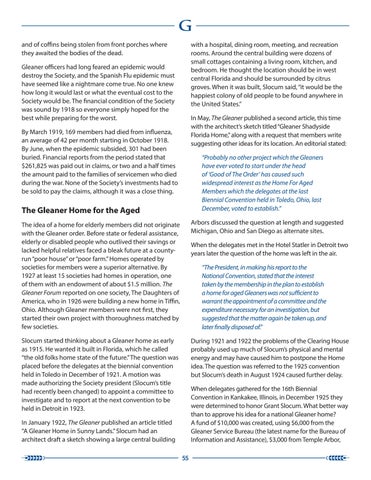and of coffins being stolen from front porches where they awaited the bodies of the dead.
with a hospital, dining room, meeting, and recreation rooms. Around the central building were dozens of small cottages containing a living room, kitchen, and bedroom. He thought the location should be in west central Florida and should be surrounded by citrus groves. When it was built, Slocum said, “it would be the happiest colony of old people to be found anywhere in the United States.”
Gleaner officers had long feared an epidemic would destroy the Society, and the Spanish Flu epidemic must have seemed like a nightmare come true. No one knew how long it would last or what the eventual cost to the Society would be. The financial condition of the Society was sound by 1918 so everyone simply hoped for the best while preparing for the worst.
In May, The Gleaner published a second article, this time with the architect’s sketch titled “Gleaner Shadyside Florida Home,” along with a request that members write suggesting other ideas for its location. An editorial stated:
By March 1919, 169 members had died from influenza, an average of 42 per month starting in October 1918. By June, when the epidemic subsided, 301 had been buried. Financial reports from the period stated that $261,825 was paid out in claims, or two and a half times the amount paid to the families of servicemen who died during the war. None of the Society’s investments had to be sold to pay the claims, although it was a close thing.
“Probably no other project which the Gleaners have ever voted to start under the head of ‘Good of The Order’ has caused such widespread interest as the Home For Aged Members which the delegates at the last Biennial Convention held in Toledo, Ohio, last December, voted to establish.”
The Gleaner Home for the Aged The idea of a home for elderly members did not originate with the Gleaner order. Before state or federal assistance, elderly or disabled people who outlived their savings or lacked helpful relatives faced a bleak future at a countyrun “poor house” or “poor farm.” Homes operated by societies for members were a superior alternative. By 1927 at least 15 societies had homes in operation, one of them with an endowment of about $1.5 million. The Gleaner Forum reported on one society, The Daughters of America, who in 1926 were building a new home in Tiffin, Ohio. Although Gleaner members were not first, they started their own project with thoroughness matched by few societies.
Arbors discussed the question at length and suggested Michigan, Ohio and San Diego as alternate sites.
Slocum started thinking about a Gleaner home as early as 1915. He wanted it built in Florida, which he called “the old folks home state of the future.” The question was placed before the delegates at the biennial convention held in Toledo in December of 1921. A motion was made authorizing the Society president (Slocum’s title had recently been changed) to appoint a committee to investigate and to report at the next convention to be held in Detroit in 1923.
During 1921 and 1922 the problems of the Clearing House probably used up much of Slocum’s physical and mental energy and may have caused him to postpone the Home idea. The question was referred to the 1925 convention but Slocum’s death in August 1924 caused further delay.
When the delegates met in the Hotel Statler in Detroit two years later the question of the home was left in the air. “The President, in making his report to the National Convention, stated that the interest taken by the membership in the plan to establish a home for aged Gleaners was not sufficient to warrant the appointment of a committee and the expenditure necessary for an investigation, but suggested that the matter again be taken up, and later finally disposed of.”
When delegates gathered for the 16th Biennial Convention in Kankakee, Illinois, in December 1925 they were determined to honor Grant Slocum. What better way than to approve his idea for a national Gleaner home? A fund of $10,000 was created, using $6,000 from the Gleaner Service Bureau (the latest name for the Bureau of Information and Assistance), $3,000 from Temple Arbor,
In January 1922, The Gleaner published an article titled “A Gleaner Home in Sunny Lands.” Slocum had an architect draft a sketch showing a large central building 55




















